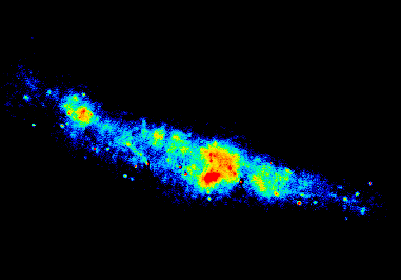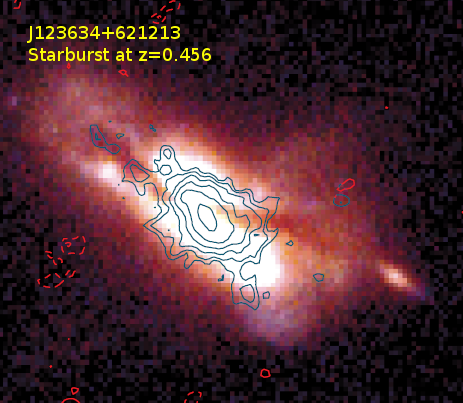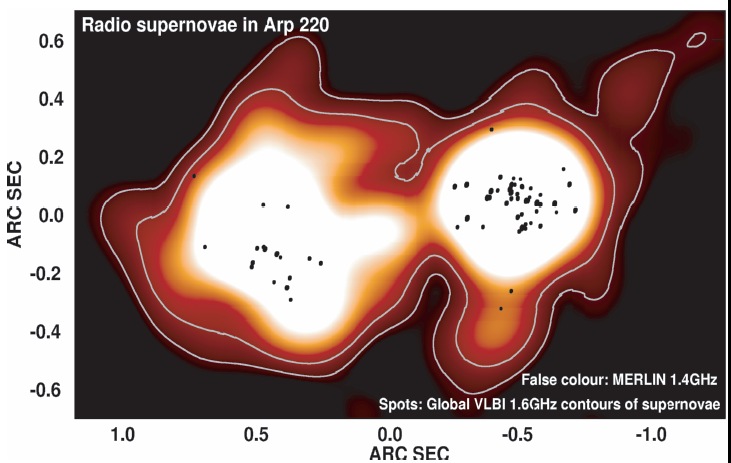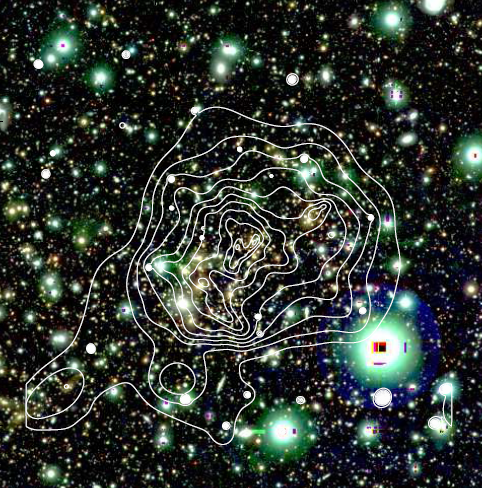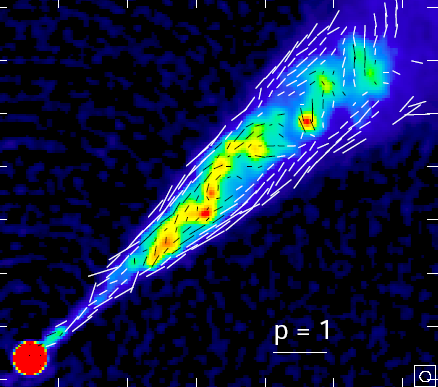Starburst & Active Galaxies with e-MERLIN
The group at JBCA is heavily involved in several e-MERLIN legacy projects working in this area. In particular we lead two of these large programmes and have strong scientific and technical involvement in several others.
Legacy e-MERLIN Multi-band Imaging of Nearby Galaxies survey (LeMMINGs)
LeMMINGs is the Legacy e-MERLIN Multi-band Imaging of Nearby Galaxies Survey. This project will observe a large a sample of nearby galaxies with sub-arcsecond angular resolution at μJy sensitivities. Such observations would allow us to study a very wide range of astrophysical phenomena, such as supernovae and their remnants, HII regions, potentially extragalactic X-ray binaries, ULX source, planetary nebular, AGN and jets and much more.
In total 860 hours of e-MERLIN time have been granted to this legacy project which will start full observations in early 2011.
The LeMMINGs project is being lead by JBCA [PI: Rob Beswick (JBCA, Manchester) and Ian McHardy (Southampton)]. Further information can be found here and the original proposal can be found here ..
The e-MERGE Survey: e-MERlin Galaxy Evolution Survey
The e-MERGE Legacy survey will exploit e-MERLIN's unique combination of sensitivity and spatial resolution to study the formation and evolution of star-forming galaxies and AGN out to redshifts of z > 5. These observations will provide a powerful, obscuration-independent tool for measuring the massive star formation and AGN activity in high-redshift galaxies, hence tracing the development of the stellar populations and the black hole growth in the first massive galaxies. With a resolution of 50-200 mas in C- and L-Bands, corresponding to < 0.5-1.5kpc at z > 1, e-MERLIN gives us our first truly reliable view of the distribution of star-formation within typical galaxies at the epoch where the bulk of the stars in the present-day Universe were being formed. e-MERLIN will disentangle the relative contributions of AGN and star-formation, an essential step given the apparently simultaneous growth of the black holes and stellar populations in galaxies. To achieve these goals, we have developed a strategy comprising of nested tiers, which together provide a single, coherent survey addressing fundamental questions about the formation and joint evolution of AGN and galaxies. The completed survey will provide a homogeneous data product with lasting legacy value for the whole astronomical community.
In total 918 hours of e-MERLIN time have been granted to this legacy project which will start initial observations in early 2011.
The e-MERGE project is being lead by JBCA [PI: Tom Muxlow (JBCA, Manchester), Ian Smail (Durham) and Ian McHardy (Southampton)]. Further information can be found here.
Luminous Infra-Red Galaxy Inventory (LIRGI)
This legacy survey will observations of 42 of the most luminous northern luminous infra-red galaxies selected from the IRAS revised Bright Galaxy Sample (Sanders et al. 2003). This survey will provide a high spatial resolution radio complement to legacy observations made with the NASA Great Observatories (GOALS program). Additionally it will itself provide legacy data to be combined with upcoming radio/millimetre/submm instruments. Our sample selects sources with L= log(Lir/Lsol) >11.4, which have sizes well matched to eMERLIN spatial resolution. The sample spans the range of FIR luminosities from the upper end of the Luminous Infra-Red Galaxies (LIRGs) to Ultra- Luminous Infra-Red Galaxies (ULIRGs), most of which are merging or post merger systems. Our local (<200 Mpc) targets have properties of area star formation densities, gas and radiation densities similar to star-forming galaxies a high redshift. A major goal of future radio/millimetre instruments is to use these high redshift objects to trace the starformation (and galaxy assembly) history of the universe. Achieving this goal reliably requires understanding the physics of similar local objects. Crucially it is important to understand how accurately radio continuum flux densities can be converted to Star Formation Rates (SFR). If for instance in the warm dense gas environments of (U)LIRGs) the stellar Initial Mass Functions is top-heavy, the calibration of SFR from star-formation tracers can be affected. Definite evidence for non-standard IMFs in extreme environments would also be an important input into understanding star-formation mechanisms in general.
This project has been allocated 353 hours of e-MERLIN time and is lead by J. E. Conway (Onsala Space Observatory, Sweden) and M. A. Perez-Torres (IAA-CSIC, Granada, Spain). Several JBCA researchers (Beswick, Diamond, Garrington) are involved in this project.
Further information can be found here.
AGATE: Astrophysics of Galaxy Transformation and Evolution
In the local Universe, some of the most fundamental properties of galaxies are found to be a strong function of environment, such as their morphologies or star-formation histories. Yet it is still unclear whether these trends reflect the initial conditions of galaxy formation (nature) or more recent environmental processing of galaxies (nurture), and answering this question is essential for unravelling the physics of galaxy formation and evolution. Massive clusters of galaxies represent some of the most extreme environments experienced by galaxies and are therefore ideal laboratories for differentiating the physical processes which can affect and transform the morphologies and star-formation properties of galaxies, efficiently providing large samples of galaxies over a wide range of local environment. Although most work has focused on the suppression of star-formation activity in galaxies as they become part of the cluster population, recent evidence has increasingly demonstrated that there must also be a period of star-formation enhancement to explain the growth of the galactic bulges. This is likely to be accompanied by a period of AGN activity to ensure the central supermassive black hole remains on the M_bulge:M_BH relation. e-MERLIN provides a unique capability to study these processes since (a) it is sensitive to the radio continuum emission produced by both AGN and star-formation activity; (b) it has a sufficiently wide field of view to image a cluster beyond the virial radius and out to where infalling groups lie; and (c) it has the angular resolution required to separate the compact AGN activity from the >~ kpc-scale circumnuclear star formation.
This project has been allocated 330 hours of e-MERLIN time and is lead by Chris Simpson (Liverpool John Moores) and Ian Smail (Durham). From JBCA Rob Beswick is involved in this project.
Further information can be found here.Resolving Key Questions in Extragalactic Jet Physics
This project will image a carefully selected sample of bright, extragalactic
radio
sources with e-MERLIN at L and C bands to provide a legacy data set for jet physics.
It is now well established that jets, on all scales, are a key astrophysical
phenomenon, and in addition they provide a mechanism for coupling the output of AGN
to their largescale surroundings. Our overarching aim is to measure the physical
properties of extragalactic jets: these are key ingredients in understanding the r?e
of radio sources in the evolution of structure in the Universe and the production of
high-energy cosmic rays. Our primary science questions include:
1. What are the dynamics of radio jets in the vicinity of the AGN? How are
low-luminosity radio jets decelerated on sub-kpc scales? What are the jet
velocities, magnetic-field structures, powers, mass fluxes and entrainment rates?
The key new aspect of the e-MERLIN observations is the ability to resolve the jets
where they first brighten.
2. What are the three-dimensional structures of powerful jets? Do they have
highly
relativistic spines e-MERLIN will allow transverse resolution of the jets with
good sensitivity for the first time.
3. What are the magnetic field configurations immediately surrounding jets? Is
there
evidence for confining fields? e-MERLIN will be able to determine Faraday rotation
measures within a single observing band at high spatial resolution.
4. Where and how are particles accelerated in the hot-spots and jets of powerful
sources? By allowing us to measure synchrotron spectra and polarization in many
discrete regions across these kpc-scale regions, e-MERLIN will enable studies of
their electron populations and magnetic field sub-structures.
We will select the brightest few representative examples of distinct types of source from well-defined samples limited by flux density and redshift and observe them with high sensitivity and image fidelity. Our targets are the defining members of their classes, and include famous objects such as Cygnus A, M87 and 3C 273. Without exception, they have a wealth of data available at radio and other wavelengths, and the new observations will have enduring legacy value.
This project has been allocated 375 hours of e-MERLIN time and is lead by Robert Laing (ESO, Garching, Germany) and Martin Hardcastle (University of Hertfordshire, UK). Several JBCA researchers (Browne, Garrington and Leahy) are involved in this project.
Further information can be found here.
